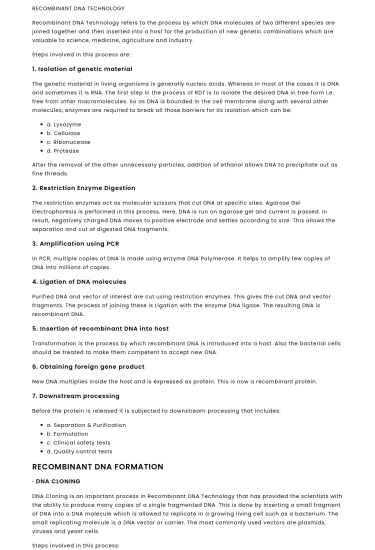RECOMBINANT DNA TECHNOLOGY
Recombinant DNA Technology refers to the process by which DNA molecules of two different species are joined together and then inserted into a host for the production of new genetic combinations which are valuable to science, medicine, agriculture and industry.
Save your time!
We can take care of your essay
- Proper editing and formatting
- Free revision, title page, and bibliography
- Flexible prices and money-back guarantee
Steps involved in this process are:
1. Isolation of genetic material
The genetic material in living organisms is generally nucleic acids. Whereas in most of the cases it is DNA and sometimes it is RNA. The first step in the process of RDT is to isolate the desired DNA in free form i.e. free from other macromolecules. So as DNA is bounded in the cell membrane along with several other molecules, enzymes are required to break all those barriers for its isolation which can be:
- a. Lysozyme
- b. Cellulase
- c. Ribonucease
- d. Protease
After the removal of the other unnecessary particles, addition of ethanol allows DNA to precipitate out as fine threads.
2. Restriction Enzyme Digestion
The restriction enzymes act as molecular scissors that cut DNA at specific sites. Agarose Gel Electrophoresis is performed in this process. Here, DNA is run on agarose gel and current is passed. In result, negatively charged DNA moves to positive electrode and settles according to size. This allows the separation and cut of digested DNA fragments.
3. Amplification using PCR
In PCR, multiple copies of DNA is made using enzyme DNA Polymerase. It helps to amplify few copies of DNA into millions of copies.
4. Ligation of DNA molecules
Purified DNA and vector of interest are cut using restriction enzymes. This gives the cut DNA and vector fragments. The process of joining these is Ligation with the enzyme DNA ligase. The resulting DNA is recombinant DNA.
5. Insertion of recombinant DNA into host
Transformation is the process by which recombinant DNA is introduced into a host. Also the bacterial cells should be treated to make them competent to accept new DNA.
6. Obtaining foreign gene product
New DNA multiplies inside the host and is expressed as protein. This is now a recombinant protein.
7. Downstream processing
Before the protein is released it is subjected to downstream processing that includes:
- a. Separation & Purification
- b. Formulation
- c. Clinical safety tests
- d. Quality control tests
RECOMBINANT DNA FORMATION
· DNA CLONING
DNA Cloning is an important process in Recombinant DNA Technology that has provided the scientists with the ability to produce many copies of a single fragmented DNA. This is done by inserting a small fragment of DNA into a DNA molecule which is allowed to replicate in a growing living cell such as a bacterium. The small replicating molecule is a DNA vector or carrier. The most commonly used vectors are plasmids, viruses and yeast cells.
Steps involved in this process:
1. Cutting and Pasting DNA
Restriction Enzymes are used for cutting DNA fragments.
Digestion is done
- To the plasmid which has a single cut site
- To target gene fragment which has a cut site near each end
DNA Ligase is used to combine fragments that allow them to link and make a recombinant plasmid containing the gene.
2. Bacterial Transformation and Selection
During transformation, specially prepared bacterial cells are given a shock that allows them to take up the foreign DNA.
After the bacteria get DNA they form colonies.
3. Protein Production
After the bacteria form colonies they are given a chemical signal that instructs them to produce target proteins. Once it forms, bacterial cells can be split open to release it. The proteins are then purified and can be used in various experiments.
Recombinant DNA Technology is useful in Industrial purposes in terms of commercial importance, improvement of fermentation processes and production of proteins from wastes.
· PROBLEMS WITH RECOMBINATION TECHNIQUE
Most of the cons of Recombinant DNA Technology are ethical in nature. According to some of the organizations, it is seen to have felt that this technology goes against the laws of natures or against the religious beliefs. Some worries are also been seen that if companies can allow scientist with patent to buy or sell genetic materials then it could become an expensive commodity. Problems with the safety of modified foods and medicines also occur.
REFERENCE
- Brondyk, W. H. (2009). Chapter 11 Selecting an Appropriate Method for Expressing a Recombinant Protein. Methods in Enzymology. 463. pp. 131–147. doi:10.1016/S0076-6879(09)63011-1. ISBN 9780123745361. PMID 19892171.
- Funke, T.; Han, H.; Healy-Fried, M.; Fischer, M.; Schönbrunn, E. (2006). 'Molecular basis for the herbicide resistance of Roundup Ready crops'. Proceedings of the National Academy of Sciences. 103 (35): 13010–13015.
- Koller, B. H.; Smithies, O. (1992). 'Altering Genes in Animals by Gene Targeting'. Annual Review of Immunology. 10: 705–730. doi:10.1146/annurev.iy.10.040192.003421. PMID 1591000.
- Johnson, I. S. (1983). 'Human insulin from recombinant DNA technology'. Science. 219 (4585): 632–637. doi:10.1126/science.6337396. PMID 6337396.
- Rosano, Germán L.; Ceccarelli, Eduardo A. (2014-04-17). 'Recombinant protein expression in Escherichia coli: advances and challenges'. Frontiers in Microbiology. 5: 172. doi:10.3389/fmicb.2014.00172. ISSN 1664-302X. PMC 4029002. PMID 24860555.
- Paine, J. A.; Shipton, C. A.; Chaggar, S.; Howells, R. M.; Kennedy, M. J.; Vernon, G.; Wright, S. Y.; Hinchliffe, E.; Adams, J. L.; Silverstone, A. L.; Drake, R. (2005). 'Improving the nutritional value of Golden Rice through increased pro-vitamin a content'. Nature Biotechnology. 23 (4): 482–487. doi:10.1038/nbt1082. PMID 15793573
- Watson, James D. (2007). Recombinant DNA: Genes and Genomes: A Short Course. San Francisco: W.H. Freeman. ISBN 978-0-7167-2866-5.
- Hannig, G.; Makrides, S. (1998). 'Strategies for optimizing heterologous protein expression in Escherichia coli'. Trends in Biotechnology. 16 (2): 54–60. doi:10.1016/S0167-7799(97)01155-4. PMID 9487731.






 Stuck on your essay?
Stuck on your essay?

